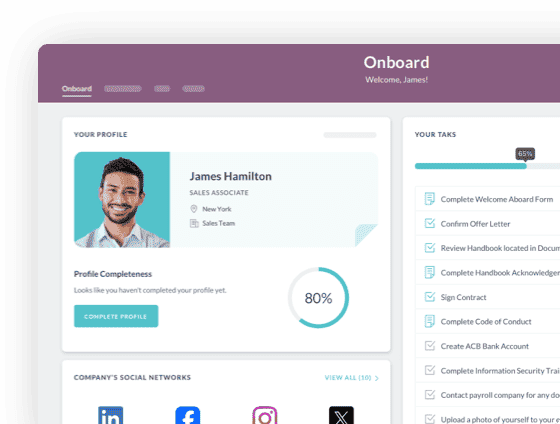
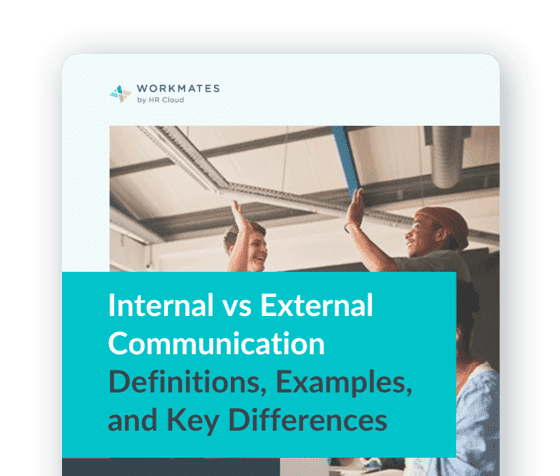
 Cut onboarding time
by 60%—here's the
Ultimate Checklist
that helped do it.
Cut onboarding time
by 60%—here's the
Ultimate Checklist
that helped do it.
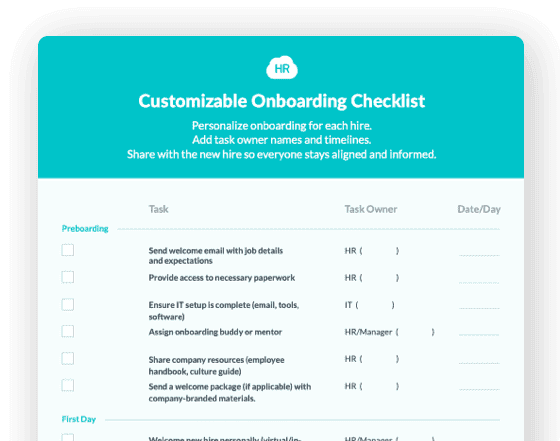
Nowadays, hiring the right developer is not the easiest nut to crack. Recruiters and companies need to go through a lot to attract tech talent. One of the very first steps is to define the requirements and needs for a given job role. Another one is to make a list of places to look for some new employees. Then, good old hunting may take place.
However, this is often turning out to be less effective than it has been before. Hence, tech companies are dying to find some new solutions in light of the ever-growing demand.
This is where employee referrals come in. As simple as it seems, there are many things for you to take into consideration before you launch employee referrals in your tech company. What should you know about it, why is it worth checking out, and how can your company benefit from increasing employee advocacy? If you have ever asked yourself any of these questions, you do not have to look for the answers any further.
Employee referrals: why should you think about implementing them?
There are at least a few reasons for believing in employee advocacy. It is not free and it takes quite a lot of time to implement, but it can pay off sooner than you think. Below you will find a few things to take into consideration.
There is high trust in referrals
The numbers speak for themselves: referrals can deliver amazing results in many fields, including recruitment. According to Career Builder (via TalentLyft), 82% of employees rate referrals “above all other sources for generating the best ROI.” Additionally, 88% of them rate referrals above all other sources for the generated quality of new hires.
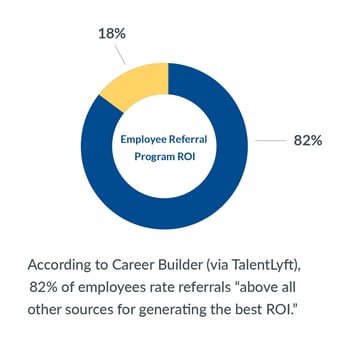
But why is this the case? Well, referrals coming from those we trust are taken seriously into consideration. We believe in the words or comments of those we know, while we tend to disagree or not trust those from people we do not. Simple as that. This is where the power of referrals comes from, and is what has just started being realized by tech companies. Involving employees in generating leads - in this case, potential candidates - can be like hitting the jackpot.
Employee referrals positively impact time to hire
According to HR Technologist, “employees hired via referrals come in 55% faster than those sourced through career sites and this could make a world of difference for competitive firms, tight schedules, and demanding product development pipelines”. Since it takes approximately 41 days to hire a developer, cutting this time in half is a definite win because you can snatch some candidates before your competitors do.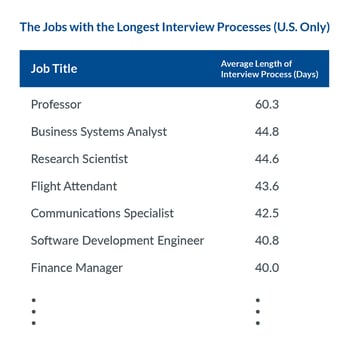
Referrals are based on genuine opinions
In the majority of cases, people who refer something to somebody are not likely to make a mistake in doing so. They trust what they recommend, or at least they should. How does it work like in tech? If a particular employee shares a genuine opinion about the workplace, it may have a great impact on someone who is considering applying to your company. What is more, it may have a great impact on someone who did not previously consider applying, but the recommendation is so tempting that they now want to give it a go.
You get access to undiscovered talent
We have just mentioned that by implementing employee referrals (and the right incentives for employees for doing so), it becomes a bit easier to convince someone to take part in the recruitment process. This includes people who were not likely to consider the offer if not for a recommendation.
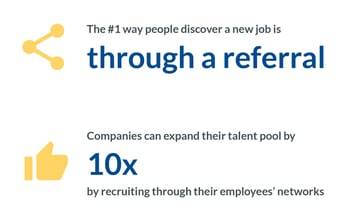
According to LinkedIn’s research, companies can expand their talent pools as much as 10x by simply utilizing their employee’s networks. This is especially true in the case of IT professionals, who tend to know people interested in the areas they are proficient in.
Many of those people are currently employed elsewhere, without any particular desire of changing that status quo. However, a persuasive recommendation may be a great impulse for a change. According to Dice, in 2020, 38% of technologists said they would change employers, down from 45% in 2019.
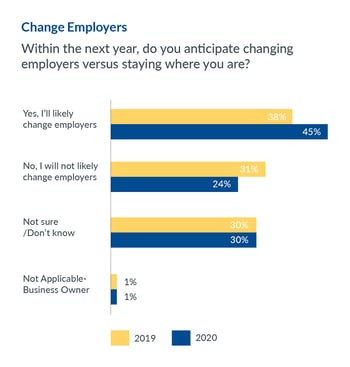
This means hiring will likely become even more difficult for employers worldwide this year. As a result, they need all the tools they can get to attract new employees.
If it comes from someone they know and trust, resigning from their current job and switching to a new one is a step closer. This way, as an employer, you get inclusive access to an undiscovered, and almost unlimited, talent pool. What is more, the quality of potential applicants in the pool is really, really high, and the recruitment process can be sped up.
Franchise Owner of Interim HealthCare SLC
“Interim Healthcare SLC needed HR technology, and we’re pleased with the results we’ve gained from HR Cloud’s solutions for recruiting, onboarding, and employee engagement. Yet it’s an opportunity for all Interim franchises. It would be so great if each franchise owner could implement similar solutions to replace legacy systems that might not work as well as they should.”
What to remember when implementing an employee referral program?
1. Onboard your employees
No matter what the terms and conditions of your referral program are, the rules need to be clear and everyone who is involved needs to be familiar with them. Employees who are really engaged and understand the rules and incentives can deliver results quicker as almighty brand ambassadors.
You need to double-check if your developer referral program is competitive and appealing enough for great employees to start recommending equally great candidates to join your team.
2. Remember to reward
Your employees will have to invest their time and networks in bringing you some new additions to the team. They do not have to do this at all, so by giving them some incentives, they can be more willing to encourage others to apply.
There is nothing wrong with rewarding people who send some great candidates your way. And while getting a nice reward is warmly welcomed, it may turn out that often a simple token of appreciation for your employees’ contribution is even more precious. Your employees can have a great impact on your company’s growth and you should never forget about this fact.
The most important thing is to keep the promises you make to your employees and keep the rules transparent. As an example, Netguru openly shares that they give iPads to those who successfully refer a new employee and that’s what they do.
3. Encourage applicants
Referrals are like gold, but alone they may not be sufficient! Potential applicants will surely peep at you on social media, your website or your LinkedIn Company Page. While they probably trust the person who referred you to them, candidates still want to see things with their own eyes. If your online presence is full of holes and not really inviting, it can put potential employees off.
4. Tech screening for the win
Your company might attract the most skilled people in the world, but they still do not have to be the best fit for your needs. While your employees may have nothing but goodwill to refer some great candidates, it may turn out that those referees do not meet the expectations of a particular project (for example, they do not have the required developer background despite being fluent in three other programming languages).
This is why tech screening is incredibly important. It can save you a lot of time, and effort, but also disappointment for both parties. Without precise tech screening, you could hire a person who does not suit the project, or the hiree may feel it is not their cup of tea from day one. And this is often what happens when the applicant tracking system is full of holes.
To wrap up
Developer referrals programs can be incredibly efficient if you have a strong company culture and set up the right rules. It is a win-win-win situation. You gain access to amazing talents without spending years trying to find them, your employees can get extra rewards and feel even more appreciated, and highly skilled developers are offered a great opportunity of joining your company. What is there not to like?
About author
Tom Winter is the CRO at DevSkiller, a developer screening and online interviews-in-one platform powered by RealLifeTesting™. Madly in love with everything tech, Tom specializes in streamlining the hiring process of tech talent and data-driven recruitment. He’s also an avid conference speaker.
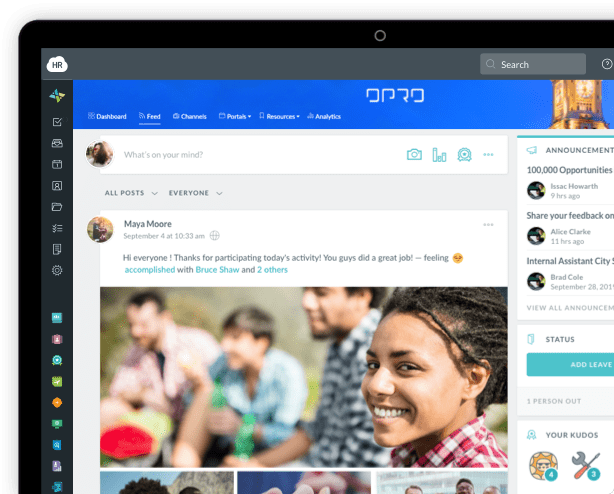
Keep Reading
A Closer Look at HR Cloud-ADP Integrations
ADP is the gold standard for payroll and core HR management. But if you’ve ever tried to
Retention Reset: How to Keep Your Best Talent in 2025
More employees are walking away from their jobs in 2025 not just for better pay, but for
The Most Common Hiring Mistakes in the Healthcare Industry
The hiring process can be tedious in the healthcare industry, and it may be tempting to
Like What You Hear?
We'd love to chat with you more about how HR Cloud® can support your business's HR needs. Book Your Free Demo

Build a Culture of Recognition. Boost Engagement. Guaranteed.
Workmates empowers employees to stay informed, connected, and appreciated—whether they’re on the front line, in the office, or remote.


Slash Onboarding Time. Boost Retention. Guaranteed.
Take the stress out of onboarding with automated workflows, digital forms, and personalized portals that help new hires feel welcome from day one.


